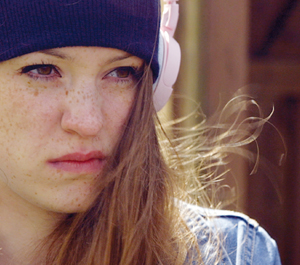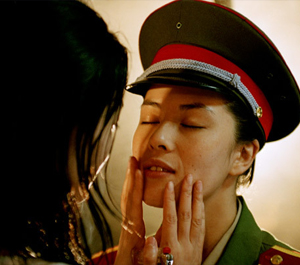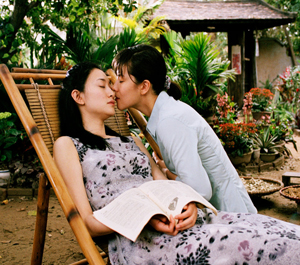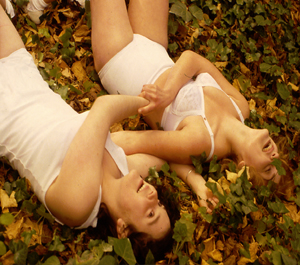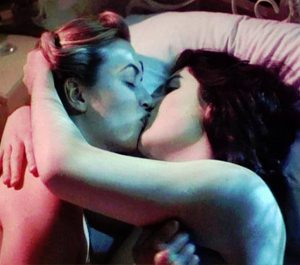Rebel, rebel (girls on film)
A desire to resist authority, control, and convention, these are just some of the things that come to mind when thinking about rebellion. We’ve all at some point in our lives performed a rebellious act. Refusing an order from a parent, a teacher, or a working task. When we’re told what to do and when to do it, how to act, how to feel and how to look, at what point do these authorities become too much?
A young 16 year old, Alex is a high school dropout who is considered a failure due to her mixing with bad crowds, use of drugs and self-harm. Faced with hardships at a young age, her adoptive mother sends her to a Northern German farm to work with horses. Monika Treut, director of OF GIRLS AND HORSES (2015), presents a display of misbehavior that transcends into a journey of self-discovery and a portrayal of female bonding. A beautiful story that deals with the coming of age with girls and the soothing landscapes of the most Northern tip of Germany at the ocean near the Danish border. Be sure to check this film out!
With rebellion in mind, I thought I’d take a look at rebellious heroines and the theme of female bonding in a selection of my favorite films. Sarah Hentges, in her book, Pictures of Girlhood: Modern Female Adolescence on Film, says that most mainstream films about rebellion are, for the most part, set in the past…the rebellion in these films is usually directed toward parents or society, but in some cases this rebellion has a larger goal to dismantle the structures. These behavioral patterns are triggered in moments of restriction, this upsurge is pushed further if the rebel is in the process of exploring her sexuality.
Love has no limits, especially when its up against the Chinese government. Set in the 1980’s in China, THE CHINESE BOTANIST’S DAUGHTER (2006) tells the story of a young orphan, Li Ming, who takes up an internship at a botanist’s garden and forms a sensual yet forbidden relationship with the daughter of the botanist, during a time when homosexuality was a punishable offence. The film is a beautiful story of two women who attempt to defy every rule of a totalitarian system, that in the end, love will always be the winning answer. No matter what your gender or sexual orientation is, the film brings a relatable urgency of how far one is willing to go for the person they love. The last few minutes of the film will no doubt leave you in tears.
Back track to the 1980’s streets of Los Angeles, littered with fast cars, over-the-top fashion and a group of friends who hit the streets to the theme song of ‘Nothing’s Gonna Stand In Our Way’ by John Farnham. Linda Blair stars in SAVAGE STREETS (1984), an exploitation flick that explores independence against an authoritative society, and a young teenager who must take action into her own hands. After her handicapped sister is raped at school (shot in the Pacific Palisades, the same location as Brian De Palma’s CARRIE (1976) – another film dealing with rebellious teens), Brenda seeks out revenge in a revealing tight leather outfit and cross-bow. The film highlights different levels of female bonding from a girls night out, to sibling love. While the horses in OF GIRLS AND HORSES become the catalyst between the two girls, this female bonding is expressed in the beautiful transition in which Brenda’s sensitive side is revealed only through the love she has for her sister and girlfriends, to a quick mood change of fierce attitudes and the rejection of all order. One cannot forget a naked Linda Blair in a brawl in the showers of the school locker room – a must see!
A teen movie like no other, HEAVENLY CREATURES (1994) is based on a true story from 1954 of two best friends, Juliet Hulme and Pauline Parker who form a close bond in which they both share every possible day with each other. Stuck in their own fantasy world, the concerned parents attempt to separate them. To ensure their everlasting connection, they both seek out revenge against their moralistic families. Before we all knew her as Rose from Titanic, Kate Winslet stars alongside Melanie Lynskey in this coming-of-age story; a real testament of teenage friendships and the worlds we invent to escape harsh reality. Sarah Hentges describes these girl genres as empowering in myriad ways, not only for girls and women, but for anyone who recognizes a lack of fit between mainstream expectations and reality. Rebellion in the form of murder, the girls met their tragic ending in a 5 year prison sentence, but the ultimate punishment was on the condition that the girls never see each other again.
The last film on my list breaks away from the coming-of-age genre of teen flicks. Similarly to SAVAGE STREETS, this film marks an important entry into the exploitation genre of rape revenge films which came about in the 1970s. Ms. 45 (1981) directed by Abel Ferrera, is a brutal portrayal of a young adolescent out for revenge after being savagely raped twice in the same day. Taking matters into her own hands, Thana, a mute seamstress, picks up a 45. caliber handgun and hits the streets on a killing spree. This transition from an innocent girl to a cold blooded killer is marked by the ritual process of applying red lipstick, slicking the hair back and dressing from head to toe in black, a common aesthetic in the films from this genre. While the social structures failed in moments of need, the female is then positioned in a negotiating state of unconscious decisions which consequence her final behaviors. Hentges further describes that the formal, institutional powers like school, family, religion and law make rules that girls are expected to follow, but the informal rules of adolescence that come from these structures also restrict girls’ behavior, social and sexual development.
From the coming-of-age teen films, exploitation genres to tragic teen love stories, this rebellious movement of bad-ass girls becomes a welcome departure from the typecast roles of stay at home wives and dutiful daughters, although these films deal with the breaking of structures in the form of death and murder, the beautiful moments of female bonding bridge an underlining message that women are capable of much more than being restricted to the confines of what society tells them. Looking back at OF GIRLS AND HORSES, the film is a good example of this transition of a troubled girl caught in the mix of abuse and lack of support to living on the German landscapes with horses as her form of escapism. This sudden shift of rebellion to the coming-of-age could only be achieved by the understanding of sexuality and the removal of societal expectations. In the words of Hentges: ‘hegemony does not have as tight a hold as it sometimes seems’.
Related Articles
- Pride and Protest
- Campbell X and THE WATERMELON WOMAN
- REINVENTING MARVIN – The Origins
- Being DISCREET with director Travis Mathews
- MARIO a revealing look at homosexuality in The Beautiful Game.
- Meet the Amatos – with THE CIAMBRA Director Jonas Carpignano
- Tamara Shogaolu talks about HALF A LIFE from Boys on Film 18: Heroes
- All about “Buddy”, in Boys on Film 18: Heroes.
- The Wound – When Controversy Prompts Conversation
- It’s All About Frankie from BEACH RATS


